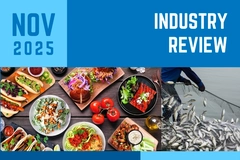
- Industry news
Industry news
- Category news
Category news
- Reports
- Key trends
- Multimedia
- Journal
- Events
- Suppliers
- Home
- Industry news
Industry news
- Category news
Category news
- Reports
- Key trends
- Multimedia
- Events
- Suppliers
Social media and “Instagrammable” food: Millennial influencers – a virtual reality?

04 Sep 2018 --- Social media has become a powerful asset to marketing within the food industry. As sharing food through social media becomes increasingly important, particularly for millennials, standout food concepts are thriving. All of this means that color is once again being embraced and celebrated in food and drink, specifically on social media platforms that provoke these trends. It is a new age of diverse choice, and standing out on the crowded shelf has never been more appealing.
According to a 2017 Innova Market Insights consumer study, novelty and variety is driving positive purchase behavior for 1 in 10 European and American consumers. Social media is driving food purchase with 1 in 10 consumers from Mexico, US, Canada, Spain, Netherlands and Australia influenced by social media to purchase food & beverages. In China and India, that number rises to 1 in 5.

“Instagrammable” food is becoming increasingly vital to millennials, so the time for foods with vibrant colors has arrived. “People create fantastic Pinterest pages. For example, they are all color-coded or highlighting specific features,” says Lu Ann Williams, Director of Innovation at Innova Market Insights.
While social media appears to be playing a huge part in the trend, natural food colors are also opening up the opportunity to deliver products that connect bright colors and health. Innova Market Insights has reported a +14 percent CAGR in food & beverage launches tracked featuring food colors from 2012 to 2016. At the same time, a 14 percent CAGR has been reported in new food and beverage launches featuring contains “natural colors”/”natural concentrates & extracts” claims (2012-2016, global). For several years, we have seen products marketed on color platforms and the trend is showing no signs of slowing down.

Naturex: “The ‘Instagrammable’ food trend isn’t just about
creating attractive images, it’s about capturing a lifestyle.”
The supplier view
Natural food colors are opening up opportunities to deliver vibrant colored foods with a clean label. Color-rich foods and spices like beetroot, spirulina and turmeric are increasingly recognized for their health benefits and are being featured on a broader number of products.
Antoine Dauby, Marketing Communications Director at Naturex, tells FoodIngredientsFirst: “According to a global Edelman survey in 2017, 57 percent of consumers either bought or boycotted brands based on their corporate values. ‘Hashtag activism’ is rapidly gaining momentum as a state of ultra-connectedness motivates millennials. They are connected, 24 hours a day, to all the social networks, including Facebook, Snapchat and Instagram, where they post, share and talk with their friends and communities.”
“In order to attract millennials, brands have had to make use of social media to position themselves as transparent players. Whether it is sharing a complaint on Twitter, posting a viral message on Facebook or opening an e-petition, consumers are having their say. They are not only highlighting poor practices on social media but also voting with their purchasing choices, forcing companies to take a stance and act ethically,” he explains.
According to Dauby, consumers don’t want artificial ingredients, but they still expect food and beverage products to look good on social media. “The ‘Instagrammable’ food trend isn’t just about creating attractive images, it’s about capturing a lifestyle,” he says. “And, if you ask any millennial, that lifestyle is all about authenticity, naturality and aesthetics.”
“In particular, our NAT color range of natural color solutions, including Vegebrite, a selection of brilliant, ‘Instagrammable’ shades made from concentrates of fruits, vegetables, edible flowers and algae, offers the perfect combo of visual appeal and authenticity. The ingredients are guaranteed to look good on social media, offering attractive pictures of food and drink that young people can share with their friends and followers,” he notes. A video interview about the product launch is available to view here.
But the trend isn’t just about the image itself. #CleanEating is a popular food hashtag on Instagram. According to Dauby, Naturex has everything you might need to feed these posts with new ingredients that are in line with the trend for clean labels, which promote clean eating.
Communal experience
“‘Instagrammable’ food is a concept of presentation for food and user-generated content that provides brand ambassadorship. ‘Instagrammable’ food is food that either looks great or stands out in some way – color, texture, ingredients. The concept expands beyond just the Instagram platform into other outlets such as Twitter, Pinterest and Tumblr as well. As consumers, we are naturally visual creatures and are drawn to beautiful photography in our social media feeds,” says Lindsey Garrett, Digital Marketing Manager for Kalsec.
Food is naturally social, communal and visual. From recipe sharing to “Instagrammable” food, it is a common topic on social media, notes Garrett. “Social media is all about that communication. It provides a platform for two-way conversations, unlike most pre-internet media that circulate one-way messages.”

it is a common topic on social media.
“This is especially vital for consumer-focused food companies, as social media has begun to take on a customer service role as well as provide a ‘personality’ to a brand. Although not food, Delta’s customer service functions on Twitter are world-class and a wonderful example of how powerful social media can be in building brand loyalty. Within consumer-focused food companies, Wendy’s Twitter account has become something of an internet phenomenon with their quick wit and immediate response to trending issues. Social media plays a communication role for business-to-business companies within the food industry as well, providing easier access to information sharing,” explains Garrett.
“Millennials and Gen Z are gaining buying power. It is important to use communication outlets that work for them, as these are the generations that grew up on social media as a viable and expected means of communication.”
Social media has a tremendous influence on global food trends, as it makes foods more visually accessible around the world. “This has created more specificity in food trends. Rather than just ‘curry,’ people are looking for ‘tikka masala’ or ‘madras curry.’ Trends in Asian foods specifically, lean more towards an individual flavor, region and ingredient, such as [Korean] kimchi, or [Vietnamese] pho. Trending topics and beautiful food photography all show up in social media feeds influencing consumers,” Garrett notes.
“This also translates into the grocery aisle where consumers have influence at their fingertips and use social media from recipe inspiration with unique ingredients to cultural food inspiration,” she tells FoodIngredientsFirst.
For DDW The Color House, social media has become an increasingly important aspect of their marketing efforts. Connie Sandusky, Ph.D., Global Marketing Director at DDW tells FoodIngredientsFirst: “Social media does relate to our business and ingredients in the B2B market and because we work in the business to business environment, our purpose for social media is about building awareness and brand meaning with relevant audiences. The number of followers is much less interesting than the quality of followers interested in specific content.”
For Kerry Taste and Nutrition (Kerry), it isn't just millennials that are driving this movement. “With everyone from Gen-Zers to Baby Boomers on social media, platforms such as Instagram have become a big part of how people share and experience food,” Stacie Levy, Global Director, Content Strategy & Integration at Kerry explains.

Content Strategy & Integration, Kerry:
“With Instagram, aesthetics are everything.”
“In an environment where food trends and fads spread quickly, savvy food and beverage manufacturers are finding opportunities to not only be a part of the conversation but also leverage social media insight tools as a way to quickly tap into consumer preferences and behaviors. In particular, at Kerry, we’re helping customers harness social data to look beyond trends that are happening today and gather insight on emerging trends that are not yet mainstream, to influence product innovation and development,” she explains.
KerryDigest recently reported on how digital proliferation and innovation have given rise to the more connected, always-on consumer – who are using social media as a platform to follow influencers that reflect their ideal lifestyle and also as a vehicle to build their persona. Kerry research shows that 52 percent of European consumers think they have good taste in food and drink, and seek products that let people know that (Kerry Compass & Discovery 2017). Levy notes: “These behaviors have given consumers access to global food trends and flavors that they may not have previously known, leading people to experiment with new tastes or the latest novel food or drink more than ever before.”
At Kerry, “Instagrammable” food means intriguing, visually appealing food that people will want to share with family and friends. “With Instagram, aesthetics are everything. Utilizing brightly colored food and giving consideration to artful style and arrangement can drive intrigue and engagement. However, for a food or beverage product to ultimately be successful, it needs to deliver beyond visual appeal and taste good – otherwise, no consumers will repeat purchase or recommend it,” she tells FoodIngredientsFirst.
In today’s connected world, it is clear that social media influences many of our everyday choices, including food consumption and purchasing behavior. The power of the internet is undeniable, and cannot be ignored. As consumers as continuously attached to their digital devices and apps – the way in which companies communicate will continue to evolve. And as we become more digitally vocal, the manner in which we process and present information through social media, really is at our fingertips.
By Elizabeth Green











